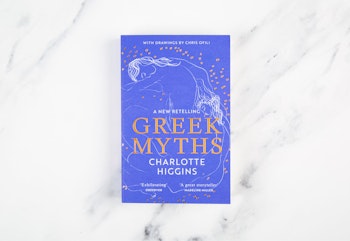In the captivating collection Greek Myths: A New Retelling, author Charlotte Higgins reinterprets timeless legends with feminine perspectives at the forefront. In this piece written just for Papier, Charlotte discusses how context can shape enduring stories, and how tales from the past can teach us something about the present.
For English speakers, the word ‘myth’ has a double resonance. On the one hand, it means something that is patently false. A repeated, received fiction. On the other hand, it contains the opposite idea: something powerfully, fundamentally true. I think part of the reason we are drawn to Greek myths now is that they live in this strange hinterland between truth and fiction.
They come at us from some deep, unknown, long-lost place and yet they do so to tell us about the present. ‘History is always then; myth is now,’ novelist Pat Barker wrote recently. ‘Greek myths’ as we know them are the material of Greek (and, later, Roman) literature and culture – the stories that decorated their ceramics, the scenes carved into their temple facades. They were the shared story-language of peoples liberally dispersed across the Mediterranean. There are no authoritative texts of the old stories of these scattered people. They were always versions of versions, tendrilling alternatives, spiralling variations.
A re-teller must make creative choices about what tales to tell and how to tell them: the sheer quantity of source material, aside from any other consideration, makes that necessary. Greek myths are full of complex, maddening, strange, violent, brave women. Because the camera has so often been pointed away from them, and so firmly at the male hero, these female characters have often been side-lined, sanitised and prettified into virtuousness – or, quite as likely, invisibility.
But who wouldn’t want to write into Apollonius of Rhodes’ wild portrait of Medea, the woman who, in his third-century BCE epic poem, does all the heavy-lifting usually associated with Jason, the man she falls in love with? Read the source material and you’ll find that it’s she who has the secret to fighting Pelias’ fire-breathing bulls; it’s she who enchants the dragon to sleep so that the Golden Fleece can be stolen; and it’s she who kills the giant Talos – unforgettable from his appearance in the Harryhausen film, which omits poor Medea entirely.
As I wrote the book, the news was full of apocalypse. California was on fire; there were disastrous floods; the start of a pandemic – signs of a planet’s delicate mechanisms pushed into chaos by human activity. Rereading the story of Phaethon, as told in Ovid’s Metamorphoses, it seemed impossible, just now, not to see in it a metaphor for the climate crisis. Phaethon, despite dire warnings, is absolutely determined to borrow his father Helios’ horses for one day, driving the Sun chariot across the sky. He can’t do it, of course: the horses veer out of control. When they plunge too near to the Earth, the land burns. When they fly too far from it, it freezes. Violence breaks out. People die. Phaethon – who only wanted to prove himself his father’s true son – was blind to the consequences.
As Sophocles had said 500 years earlier, of all the things that walk upon the surface of the Earth, there is nothing so wonderful, so terrible, as humans. Greek myths are often called timeless. I’m not sure: I think of them as timely.
To read more of Charlotte's wise words about mythology, pick up a copy of her spellbinding new collection Greek Myths, now out in paperback and featuring original artworks by Chris Ofili.



